Edinburgh Street Tramways
History
Edinburgh's first street tramway, which was standard-gauge and horse drawn, opened on the 6th November 1871, the first section running between Haymarket (in Edinburgh) and Bernard Street (in Leith). The tramway was owned and operated by the Edinburgh Street Tramways Company, which obtained powers to build a series of lines on the 29th June 1871, under the Edinburgh Street Tramways Act 1871.
The first services were delivered using 10 horsecars, the cars being owned by the company and the horses initially provided by a contractor. This first line was gradually followed by others: from the Foot of Leith Walk to Junction Bridge (3rd February 1872), from the Post Office to Duncan Street, Newington (29th May 1872), from Salisbury Place to Marchmont, along Grange Road (6th July 1872), and from the West End to Grange Road via Churchill (11th November 1872).
The company had three years to complete the initial tranche of authorised lines, but ran out of time, having to apply for an extension to the time allowed, this being granted on the 5th August 1873 under the Edinburgh Street Tramways Act 1873. Further lines were opened between Haymarket and Coatbridge (29th May 1873), and along Ferry Road in Leith to Newhaven (17th January 1874).
The relationship between the ESTCo and the good burghers of Edinburgh and Leith was not exactly harmonious, the company coming in for heavy criticism of its services, the laying of the track, and the treatment of its horses, though all were gradually improved.
Yet another act of parliament was required to extend the time allowed for the widening of North Bridge, and to abandon some planned lines on the north side of the Princes Street, where the steepness of the streets would have made horse-tram operation extremely difficult; sanction for these changes was obtained on the 3rd June 1874 under the Edinburgh Street Tramways Act 1874, with further changes being authorised on the 19th July of the following year under the Edinburgh Street Tramways Act 1875. The final line of the those originally authorised, from Waterloo Place to Portobello, was opened on the 14th May 1875.
By 1877, the original track was giving trouble, and over the next few years, much work was done to replace sections of it with rail of a heavier specification.
Although the company's relationship with the councils was often fractious, especially in respect of the fares charged, the company managed to get their buy-in to a significant expansion of the system. Powers for these, as well as to run omnibuses, were granted on the 31st August 1881 under the Edinburgh Street Tramways Act 1881.
The company experimented with steam traction in the 1880s, operating services on the Portobello route from 12th July 1881 to the 27th October 1882. Although the services appear to have been a success, Edinburgh Town Council refused to renew the licence to use steam on the 12th September 1882, shortly followed by Portobello Town Council, the usual objections (smoke, noise etc.) being cited as the reasons. Although the company sought and obtained powers to use mechanical traction — granted on the 12th July 1882 — under the Edinburgh Street Tramways (Mechanical Power) Act 1882, the approval of the respective Town Councils was still required, and this was not forthcoming.
Meanwhile, powers for another extension to the horse-tramway system had been obtained on the 3rd July 1882, under the Edinburgh Street Tramways Act 1882. New lines authorised under the 1881 and 1882 Acts opened as follows: from the Foot of Leith to Restalrig Road (1st May 1882); Junction Bridge in Leith to the bottom of North Junction Street, also in Leith (June 1882); Haymarket to Ardmillan Terrace, and Granville Terrace to North Bridge via Lauriston Place (1st August 1882); Churchill to Morningside Drive (26th May 1883); Granville Terrace to Colinton Road, and Polwarth Terrace to Ardmillan Terrace (1st November 1883).
The company now settled down to a profitable existence, only clouded by the threat of municipalisation, Edinburgh Corporation having the right to purchase the original tranche of lines — under the Tramways Act of 1870 — 21 years from their authorisation. During August 1890, the council made it known that it intended to purchase these lines, formally taking the decision to do so on the 1st December 1891. The company was probably not unduly concerned by this course of action, as local authorities were not allowed (at the time) to operate tramways, so it could reasonably have expected to enter into a lease agreement with the corporation. Planning ahead, the company reached agreement with both Leith Town Council and Portobello Town Council to keep operating within their respective areas. The company subsequently obtained powers on the 27th June 1892, under the Edinburgh Street Tramways Act 1892, to enter into leases, and to use mechanical and/or electric traction.
On the 12th August 1892, Edinburgh Corporation unilaterally served notice to purchase on the ESTCo, no doubt causing major irritation to the authorities in Leith and Portobello, which had hoped to agree a common approach. Another bone of contention was the desired mode of traction, with Edinburgh Corporation seemingly intent on converting the horse tramway (within its boundaries) to cable traction, whereas Leith Corporation was opposed to this (within its boundaries), favouring overhead electric traction; the ESTCo was unfortunately caught between the two, trying its best to meet the conflicting needs of its two potential masters. As per its agreement with Leith Corporation, the company now obtained powers to build extensions (within Leith), these being granted on the 9th June 1893 under the Edinburgh Street Tramways Act 1893. Barely two weeks later, Edinburgh Corporation received its own powers (on the 29th June 1893), to enter into a 21-year lease and to convert the horse tramway tracks within its municipal boundary to cable traction.
The lease was duly put out to tender, and no doubt to the ESTCo's chagrin, having made a competitive offer, when the successful bidder was announced — on the 11th October 1893 — it turned out to be Messrs Dick Kerr and Company Limited of Kilmarnock. The corporation took possession of all the lines within the city on the 9th December 1893 (circa 11.75 miles), bar the tracks from Waterloo Place to Jocks Lodge on the Portobello line. The deal included 70 horsecars and 600 horses, all of which were immediately sold on to DK&Co; the ESTCo was left with 29 cars and 298 horses, having effectively been reduced to a third of its former size.
On the 6th March 1894, DK&Co formed the Edinburgh and District Tramways Company, the latter taking over the former's Edinburgh lease in the following July. Whilst through services between Edinburgh and Leith were initially maintained, the respective companies could not reach agreement on the precise details, which ended — on the 24th December 1894 — with a Board of Trade arbitration decision to maintain through tramcar services, but with the horses and crews being changed at the municipal boundary at Pilrig. This arrangement benefitted no one, least of all the travelling public, though it was in fact destined to get worse.
On the 8th January 1896, Edinburgh Corporation informed the ESTCo of its intention to purchase the Waterloo Place to Jocks Lodge section of the Portobello line, which it did on the 31st January 1896; this inevitably led to another through-service changeover (at Jocks Lodge) from E&DTCo horses and men to those of the ESTCo. Later that year the City of Edinburgh was expanded to include Portobello, so it was only a matter of time before Edinburgh Corporation would seek to acquire the rest of the Portobello line. Despite this, powers for an extension from Portobello to Joppa were secured on the 7th August 1896 — under the Edinburgh Street Tramways Company Act 1896 — the extension opening in May 1897. Sensing which way the wind was blowing, the 1897 Act also included powers for the ESTCo to sell its undertaking at an agreed price.
The ESTCo system duly shrank again on the 30th June 1898 when the Portobello line passed into the hands of Edinburgh Corporation at a mutually agreed price.
The situation at Pilrig remained problematical, but became even worse, at least for passengers, with the official commencement of cable-hauled services on the line on the 26th October 1899, through running of cars now being impossible. Although multiple attempts to create a unified tramway were made, all ultimately failed, though several came close to succeeding, including an attempt by the E&DTCo to persuade Leith Corporation to purchase the ESTCo and then lease it to the E&DTCo.
The ESTCo's last extensions, both in Leith (from Bernard Street to Commercial Street, and from Stanley Road to Newhaven), were opened on the 24th March 1900.
Finally, on the 1st June 1903, the ESTCo accepted an offer by Leith Corporation to purchase the undertaking. The latter had hoped that the E&DTCo would lease it and convert it to electric traction, but the company was only prepared to work it if it were converted to cable traction, so once again the chance for a unified system, went begging, a situation that was only resolved in 1920 when Edinburgh expanded to incorporate Leith.
The ESTCo ran its last horse services on the 22nd October 1904, Leith Corporation taking over the following day. The last horse tram service of all in Leith ran just over one year later on the 2nd November 1905.
The ESTCo operated 18.53 miles of standard-gauge tramway in Edinburgh, Leith and Portobello, though the system shrank and expanded as portions of its system were municipalised, and new extensions opened. From Princes Street, lines ran: northeastwards to Leith; eastwards to Joppa; southeastwards to Powburn;, southwards to Morningside; southwestwards to Craiglockhart (Colinton Road, and Ardmillan Terrace; and westwards to Coatbridge. There were also a significant number of interconnecting lines.
Uniforms
Photographs of staff from the earliest years of the system appear not to have survived, but according to D L G Hunter (see reference below), dark blue uniforms were issued in 1874; these had green or red collars (for drivers and conductors, respectively). The caps, which were probably in a kepi style, bore hat bands of varying colours, the colours corresponding to the route colours used on the tramcars; the coloured hatbands did not, however, last long, having been dispensed with by 1876.
By the mid-1890s, and possibly from much earlier, horsecar crews were wearing single-breasted jackets with four buttons (bearing the full company title and twin shields — see link) and lapels, the collars bore 'E S T' initials in individual metal letters, probably nickel. By this time the kepi-style caps bore piping around the circumference (approximately two-thirds the way up the crown), but in a colour that was the same as the cap. Staff were also provided with double-breasted overcoats with four pairs of buttons and high, fold-over collars; the latter carried 'E S T' initials on each side, almost certainly in nickel.
There is circumstantial evidence to suggest that crews, as well as trace horse boys, may at one time have been issued with armbands bearing a brass number; however, neither an example nor photographic evidence has survived.
Inspectors wore double-breasted jackets with lapels, the collars bearing the grade — 'Inspector' — in embroidered script lettering. Their kepi-style caps were very similar to those provided to tramcar crews, but with a single line of piping (of a light colour) around the circumference, approximately half-way up, and a pom pom in the centre on the crown (top); no cap badge was worn. The uniforms were changed some time in the mid-1890s; although remaining double-breasted, they now bore elaborate 'E S T' initials on each collar, rather than 'Inspector'. Instead of the early piping, the kepi-style caps now bore a wide hat band of a lighter colour than the cap, around the circumference (at the bottom).
Further reading
For a detailed history of the Edinburgh Street Tramways Company, see: 'Edinburgh's Transport - Volume 1, The Early Years' by D L G Hunter; The Mercat Press (1992).
Images
Horse tram drivers and conductors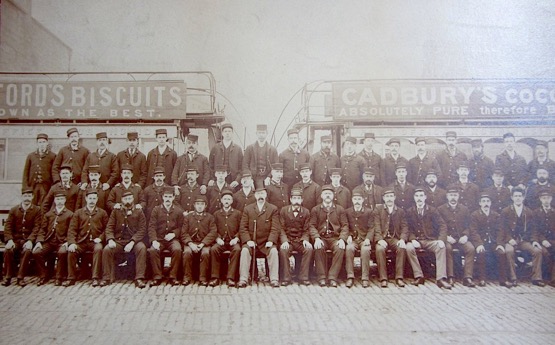
ESTCo staff photo — undated, but probably taken in the early-to-mid 1890s. Apart from the top-hatted gentleman (presumably the General Manager or a major shareholder), the only other senior staff member present is an inspector, seated immediately next to him on the right.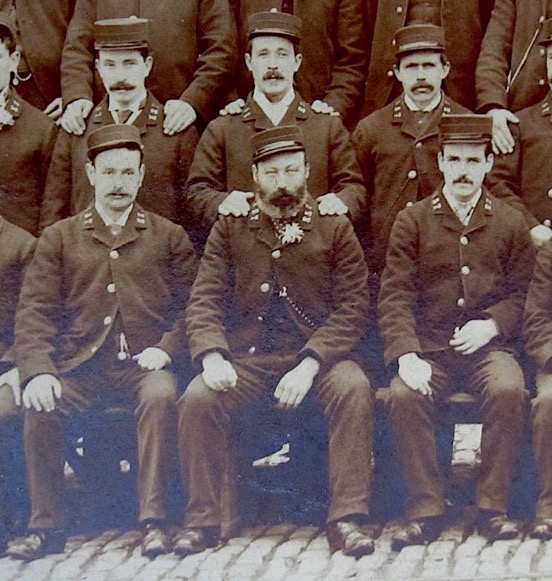
An enlargement of the above photograph showing a group of conductors and drivers. Whilst their collars bear 'E S T' initials (on both sides), their kepi-style caps are plain, save for a band of piping around the circumference.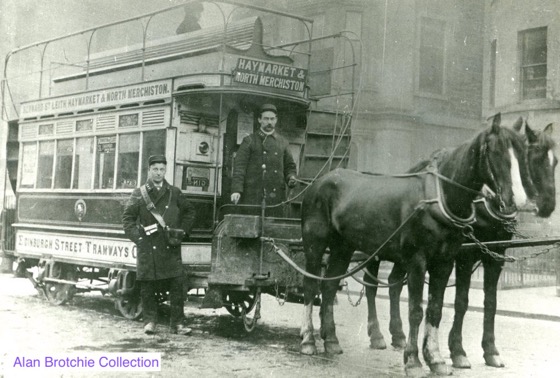
ESTCo Horse Car No 29 at the Bernard St terminus in Leith — photo undated, but probably taken in the early-to-mid 1890s.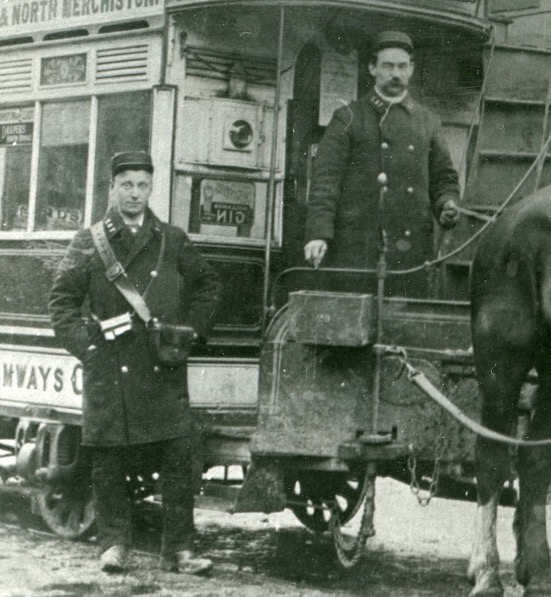
An enlargement of the above photograph showing the crew. The overcoats bear 'E S T' initials on the collars; the kepi-style caps are as usual without a badge of any kind.
Senior staff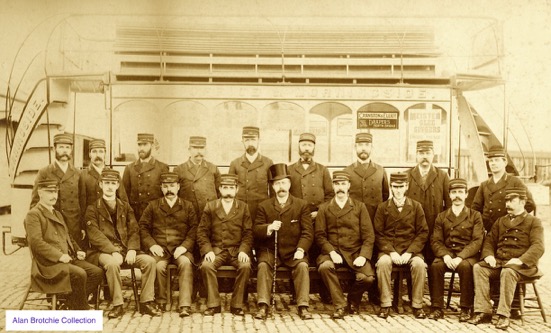
An excellent photograph of what is probably the entire senior uniformed staff of the Edinburgh Street Tramways Company. Although the photo is undated, the poster in the window of the tram advertisers the 'Meister Glee Singers', who opened at the Empire Palace on 7th November 1892 (with thanks to Alan Brotchie for this information). The man seated to the right of the top-hatted gentleman is the same individual who is seated to the right of the same gentleman in the staff photo shown above.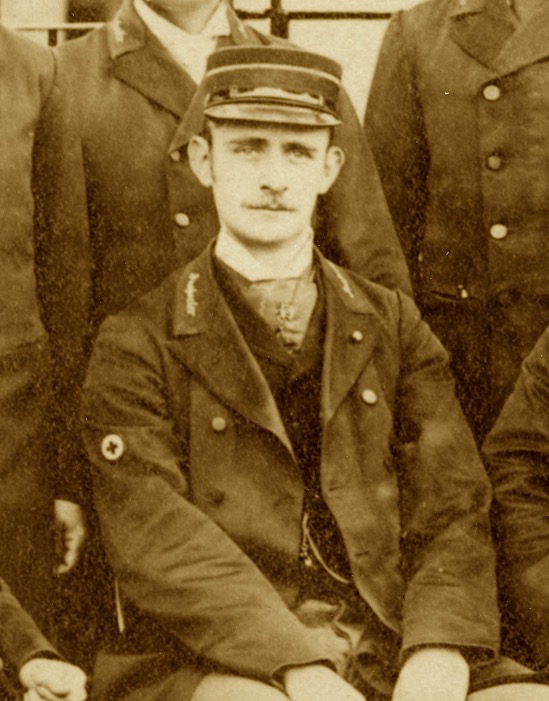
An enlargement of the above photograph showing the uniform details of one of the inspectors, including the grade — 'Inspector' — embroidered on the collars. The cross on the subject's right-hand jacket sleeve probably signifies membership of a volunteer group such as the St Johns Ambulance Brigade.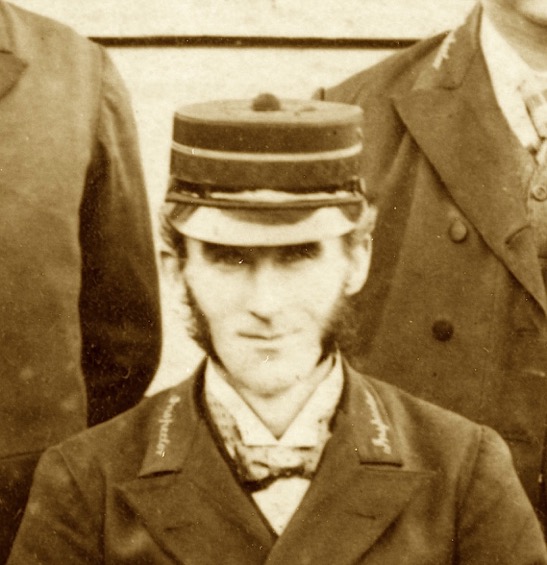
Another blow-up of the 1892 senior staff photo above, revealing the pom pom on top of the kepi-style cap of the splendidly mutton-chopped subject.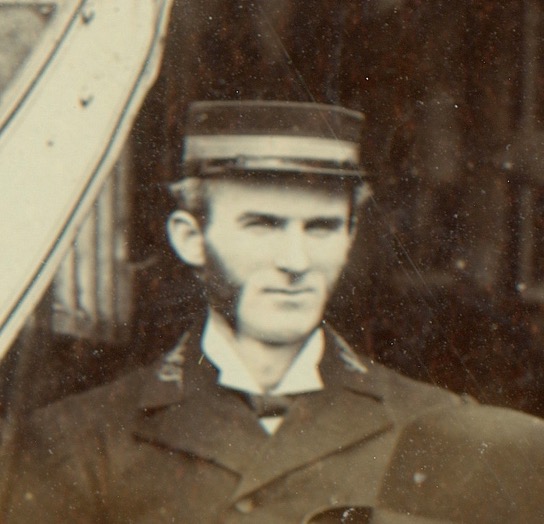
The same individual as above, but six years later (see below). Note the new uniform with elaborate 'E S T' embroidered initials rather than the bearer's grade.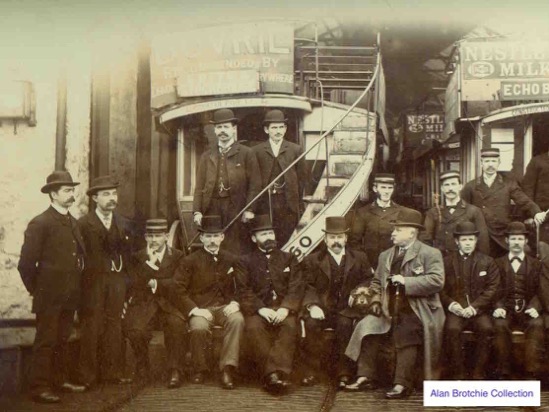
Half of a large photograph of the ESTCo's senior staff taken on or shortly before the 9th May 1898 (the date on the photo mount) at Leith depot, Smith's Place, Leith Walk. By this time, the ESTCo was a much smaller organisation, having shrunk dramatically from its zenith, as its routes were taken over by Edinburgh Corporation, then leased to the Edinburgh and District Tramways Company.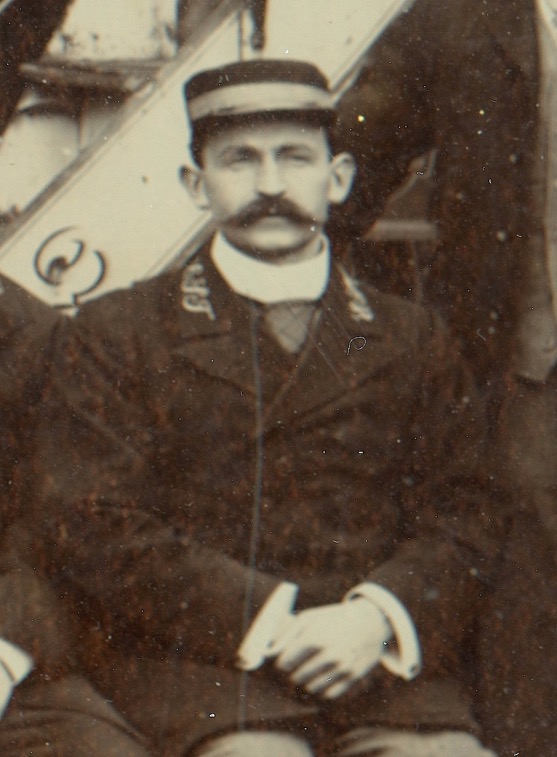
Another enlargement of the 1898 photograph, showing an inspector.